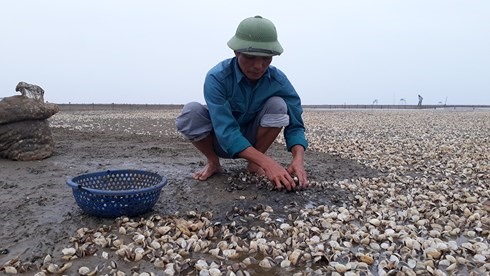 Society
Society

Hundreds of thousands of clams have reportedly died en masse over the past week in Hai Loc Commune in the northern province of Thanh Hóa’s Hậu Lộc District, leaving farmers in debt.
 |
| A local resident collects dead clams. Hundreds of thousands of clams have reportedly died en masse over the past week in Hải Lộc Commune in the northern province of Thanh Hóa’s Hậu Lộc District. — Photo infonet.vn |
THANH HÓA — Hundreds of thousands of clams have reportedly died en masse over the past week in Hải Lộc Commune in the northern province of Thanh Hóa’s Hậu Lộc District, leaving farmers in debt.
Local residents said it was the worst incident that they had faced over the past 10 years. Previously, the loss was about 20 to 30 per cent of the crop.
“I noticed that clam deaths began about 10 days ago, when I visited the farm. The number of dead clams continued to rise in the following days, and eventually there was a mass death, causing billions of đồng in damage,” said Phạm Văn Quý, a resident of Hải Lộc Commune’s Lộc Tiến Village, who owns 6ha of clams.
“Not only did we suffer capital loss, we also had to spend dozens of millions of đồng to hire workers to pick up the dead clams every day,” he said.
Đoàn Văn Lộc, another resident, said that dead clams from his 2ha-farm amounted to over 100 tonnes. The loss was estimated at over VNĐ1.2 billion (US$51,720), he said, adding that half of that amount had been borrowed from a bank.
Nguyễn Thị Hương, a local resident, also faced the same situation.
“My family mortaged the land-use right certificate to the bank for VNĐ350 million to invest in clam farming, but now all the clams have died. We don’t know how we can get money for the new crop,” she said.
Nguyễn Quốc Tý, chairman of Hải Lộc Commune, said that many clam farmers had reported up to 60 to 70 per cent of dead clams, and others 100 per cent.
Local authorities have calculated the amount of dead clams and asked responsible agencies to take water samples for testing to determine the cause, he said, adding that 170 households engage in clam breeding on an area covering 170ha. — VNS